- Главная
- Разное
- Бизнес и предпринимательство
- Образование
- Развлечения
- Государство
- Спорт
- Графика
- Культурология
- Еда и кулинария
- Лингвистика
- Религиоведение
- Черчение
- Физкультура
- ИЗО
- Психология
- Социология
- Английский язык
- Астрономия
- Алгебра
- Биология
- География
- Геометрия
- Детские презентации
- Информатика
- История
- Литература
- Маркетинг
- Математика
- Медицина
- Менеджмент
- Музыка
- МХК
- Немецкий язык
- ОБЖ
- Обществознание
- Окружающий мир
- Педагогика
- Русский язык
- Технология
- Физика
- Философия
- Химия
- Шаблоны, картинки для презентаций
- Экология
- Экономика
- Юриспруденция
Что такое findslide.org?
FindSlide.org - это сайт презентаций, докладов, шаблонов в формате PowerPoint.
Обратная связь
Email: Нажмите что бы посмотреть
Презентация на тему Hitchhiking(as a way of travelling)
Содержание
- 2. MeaningHitchhiking (also known as thumbing or hitching) is a means of transportation that
- 3. HistoryPeople call Mikhail Lomonosov the most famous
- 4. Signaling method The hitchhikers' methods of signaling
- 5. A typical hitchhiker's gestureHitchhiking in New Zealand in 2006
- 6. Legal status Hitchhiking is a historically common
- 7. In all countries in Europe, it is
- 8. Types of Hitchhiking The first kind –
- 9. Safety Very little data is available regarding
- 10. Around the world CubaIn Cuba, picking up
- 11. NetherlandsHitchhiking (called liften) is legal in the Netherlands. This
- 12. Pros and cons of HitchhikingHitchhiking is not
- 13. Скачать презентацию
- 14. Похожие презентации
MeaningHitchhiking (also known as thumbing or hitching) is a means of transportation that is gained by asking people, usually strangers, for a ride in their automobile or other road vehicle. A ride is usually, but not always free.

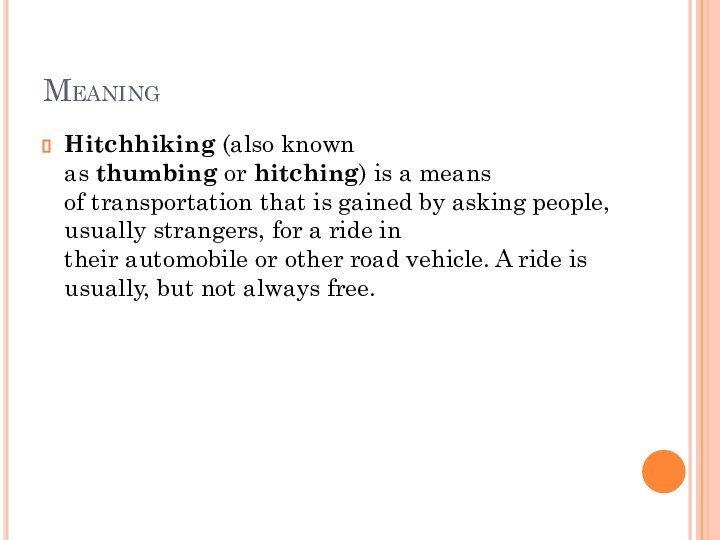
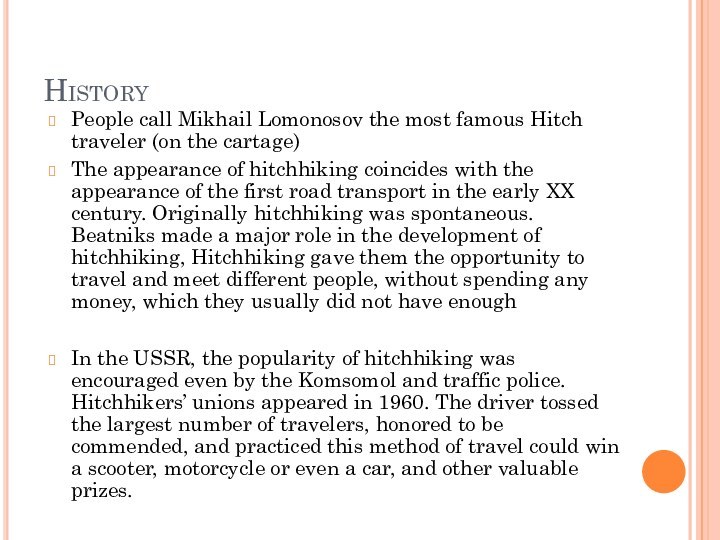
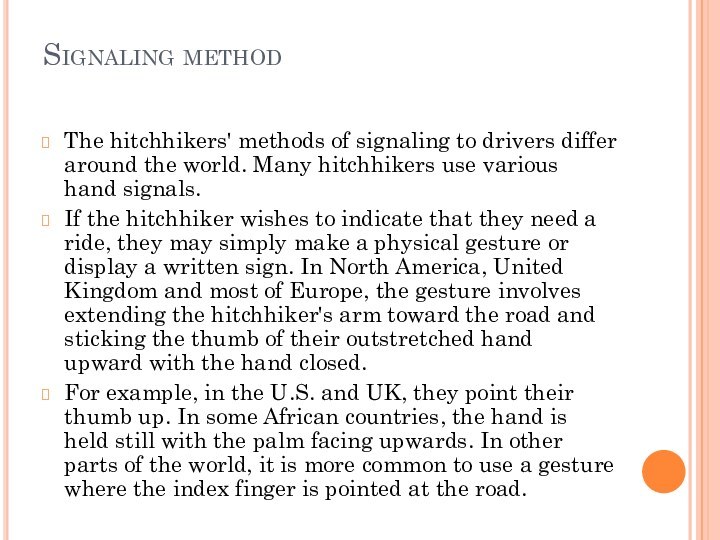
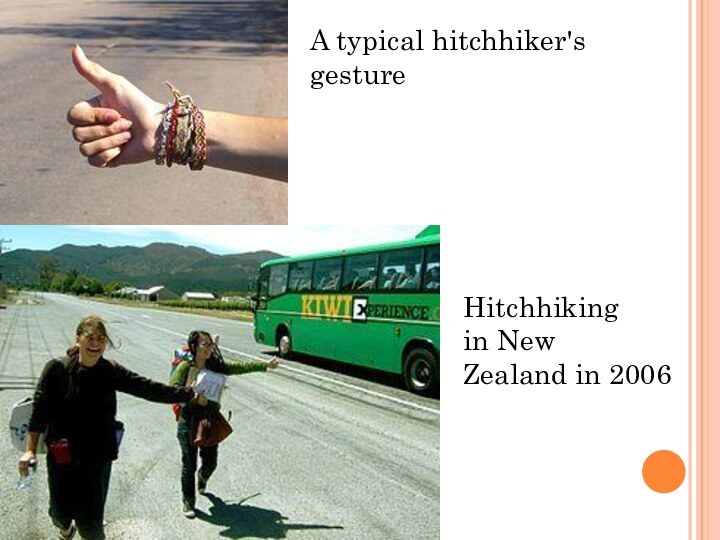
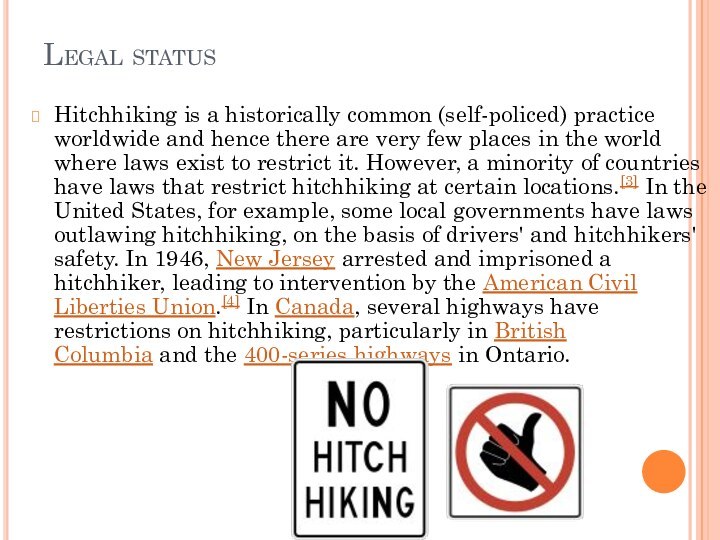
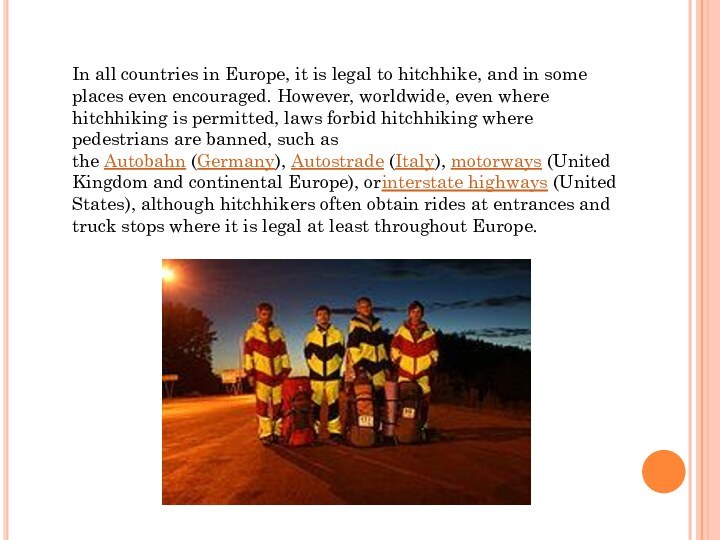
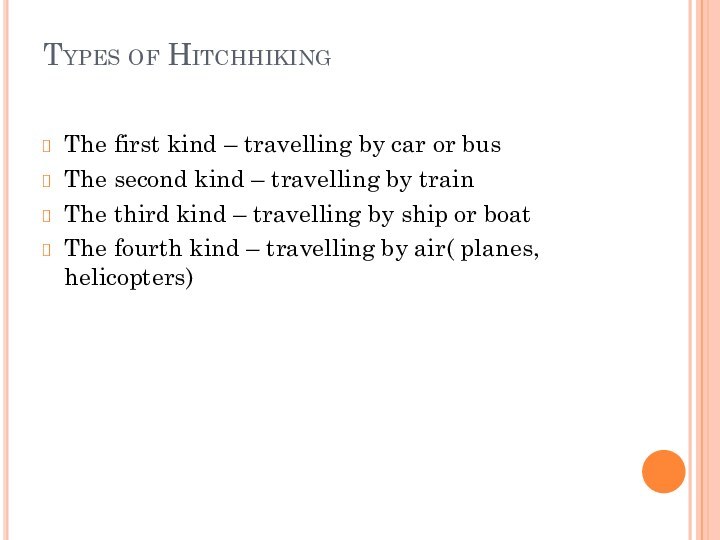
![Hitchhiking(as a way of travelling) Safety Very little data is available regarding the safety of hitchhiking.[8] Compiling good](/img/tmb/14/1350617/189f13dde4905c241f339ad5493548c4-720x.jpg)
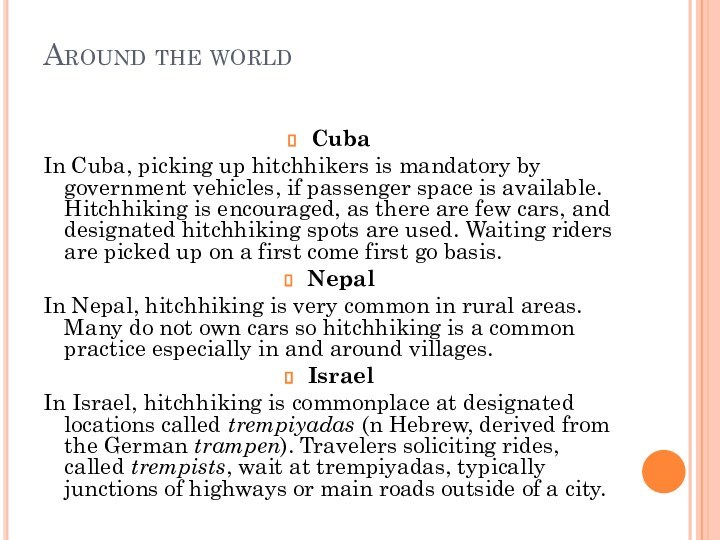

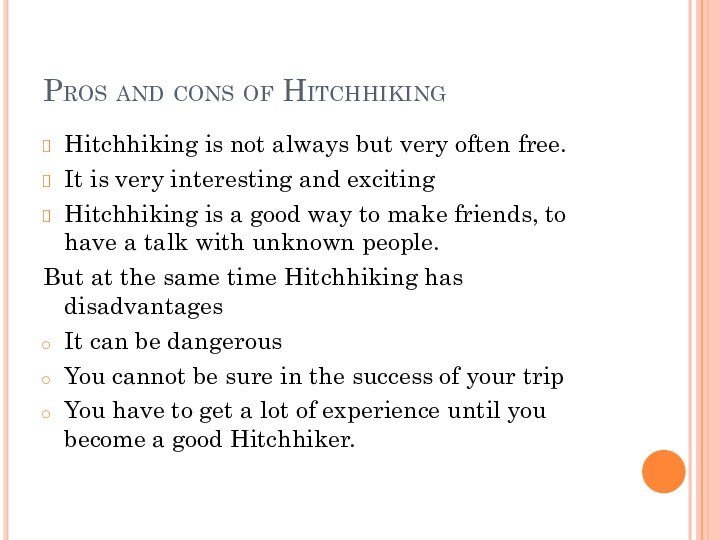

Слайд 2
Meaning
Hitchhiking (also known as thumbing or hitching) is a means of transportation that is
Слайд 3
History
People call Mikhail Lomonosov the most famous Hitch
traveler (on the cartage)
The appearance of hitchhiking coincides with
the appearance of the first road transport in the early XX century. Originally hitchhiking was spontaneous. Beatniks made a major role in the development of hitchhiking, Hitchhiking gave them the opportunity to travel and meet different people, without spending any money, which they usually did not have enoughIn the USSR, the popularity of hitchhiking was encouraged even by the Komsomol and traffic police. Hitchhikers’ unions appeared in 1960. The driver tossed the largest number of travelers, honored to be commended, and practiced this method of travel could win a scooter, motorcycle or even a car, and other valuable prizes.
Слайд 4
Signaling method
The hitchhikers' methods of signaling to drivers
differ around the world. Many hitchhikers use various hand
signals.If the hitchhiker wishes to indicate that they need a ride, they may simply make a physical gesture or display a written sign. In North America, United Kingdom and most of Europe, the gesture involves extending the hitchhiker's arm toward the road and sticking the thumb of their outstretched hand upward with the hand closed.
For example, in the U.S. and UK, they point their thumb up. In some African countries, the hand is held still with the palm facing upwards. In other parts of the world, it is more common to use a gesture where the index finger is pointed at the road.
Слайд 6
Legal status
Hitchhiking is a historically common (self-policed) practice
worldwide and hence there are very few places in
the world where laws exist to restrict it. However, a minority of countries have laws that restrict hitchhiking at certain locations.[3] In the United States, for example, some local governments have laws outlawing hitchhiking, on the basis of drivers' and hitchhikers' safety. In 1946, New Jersey arrested and imprisoned a hitchhiker, leading to intervention by the American Civil Liberties Union.[4] In Canada, several highways have restrictions on hitchhiking, particularly in British Columbia and the 400-series highways in Ontario.Слайд 7 In all countries in Europe, it is legal
to hitchhike, and in some places even encouraged. However,
worldwide, even where hitchhiking is permitted, laws forbid hitchhiking where pedestrians are banned, such as the Autobahn (Germany), Autostrade (Italy), motorways (United Kingdom and continental Europe), orinterstate highways (United States), although hitchhikers often obtain rides at entrances and truck stops where it is legal at least throughout Europe.
Слайд 8
Types of Hitchhiking
The first kind – travelling by
car or bus
The second kind – travelling by train
The
third kind – travelling by ship or boatThe fourth kind – travelling by air( planes, helicopters)
Слайд 9
Safety
Very little data is available regarding the safety
of hitchhiking.[8] Compiling good safety data requires counting hitchhikers, counting
rides, and counting problems: a difficult task.[9]Two studies on the topic include a 1974 California Highway Patrol study and a 1989 German federal police study.[8] The California study found that hitchhikers were likely to be victims of crime.[10] The German study concluded that the actual risk is much lower than the publicly perceived risk, and the authors did not advise against hitch-hiking in general.[11] They found that in some cases there were verbal disputes and inappropriate comments, but physical attacks were very rare.[12]
Recommended safety practices include:[13]
Asking for rides at gas stations instead of signaling at the roadside.
Trusting one's instincts.
Refusing rides from impaired drivers.
Hitchhiking during daylight hours.
Слайд 10
Around the world
Cuba
In Cuba, picking up hitchhikers is
mandatory by government vehicles, if passenger space is available.
Hitchhiking is encouraged, as there are few cars, and designated hitchhiking spots are used. Waiting riders are picked up on a first come first go basis.Nepal
In Nepal, hitchhiking is very common in rural areas. Many do not own cars so hitchhiking is a common practice especially in and around villages.
Israel
In Israel, hitchhiking is commonplace at designated locations called trempiyadas (n Hebrew, derived from the German trampen). Travelers soliciting rides, called trempists, wait at trempiyadas, typically junctions of highways or main roads outside of a city.
Слайд 11
Netherlands
Hitchhiking (called liften) is legal in the Netherlands. This sign
indicates a good place to get a lift.
In the Netherlands,
hitchhiking is legal and there are official signs where one may wait for a ride. These designated hitchhiking locations are called liftershalte or liftplaats in Dutch, and they are particularly common in university towns.Poland
Hitchhiking was legalised and formalised in Poland in 1957. Hitchhikers could buy booklets including coupons from travel agencies. These coupons were given to drivers who took hitchhikers. By the end of each season drivers who collected the highest number of coupons could exchange them for prizes and others took part in a lottery. This so-called "Akcja Autostop" was popular till the end of the 1970s, but the sale of the booklet was discontinued in 1995.
Слайд 12
Pros and cons of Hitchhiking
Hitchhiking is not always
but very often free.
It is very interesting and exciting
Hitchhiking
is a good way to make friends, to have a talk with unknown people.But at the same time Hitchhiking has disadvantages
It can be dangerous
You cannot be sure in the success of your trip
You have to get a lot of experience until you become a good Hitchhiker.





























